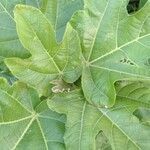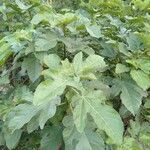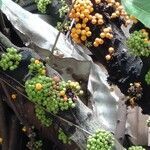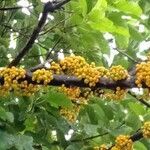Tree up to 20 m tall. Leafy twigs 3-8 mm thick, whitish hispidulous to (sub)glabrous, ± scabrous; internodes mostly hollow. Leaves (sub)opposite or spirally arranged, pairs on horizontal twigs usually unequal; lamina elliptic to oblong to (sub)ovate (to subcordiform), 10-32 by 7-20 cm, symmetric or ± asymmetric, chartaceous, apex acuminate, base cordate to rounded, margin crenate-dentate to subentire; upper surface hispidulous, scabrous, lower surface sparsely to densely whitish (sub)hispidulous on the veins, scabrous; cystoliths on both sides; lateral veins 5-10 pairs, the basal pair up to 1/3-1/2 the length of the lamina, these and also some of the lower lateral veins branched or furcate, tertiary venation (laxly) scalariform; waxy glands in the axils of both basal lateral veins or also smaller ones in the axils of other lateral veins; petiole 2-9 cm long, varying considerably to slightly in length on the same twig, whitish hispidulous to densely puberulous, the epidermis persistent; stipules semi-amplexicaul, 0.5-1 cm long, sparsely minutely strigillose, caducous (or subpersistent). Figs axillary, in pairs or solitary, mostly ramiflorous to cauliflorous, on (clusters of) leafless branchlets with short internodes, down to the trunk; peduncle 1-5 cm long; peduncular bracts 1-3(-4), scattered, c. 1 mm long; receptacle (sub)globose, 0.8-1.5(-2) cm diam. when dry, hispidulous and scabrous or glabrous and smooth, (usually) with few 0.5-1 mm long lateral bracts, yellow to blood-red at maturity, apex ± convex to almost flat, ostiole c. 3 mm diam., surrounded by a low rim; internal hairs few to abundant, whitish to brownish. Tepals whitish to reddish, (sparsely) hairy at the apices. Styles glabrous.
More
A fig. It is a tree. It grows 20 m tall. The twigs are 3-8 mm thick and leafy. The leaves are opposite and arranged in spirals. They are oval to oblong and papery. The leaves are whitish underneath. The fruit are in the axils of leaves either occurring singly or in pairs. They can also be in clusters on stems and leafless branches. The fruit are yellow to red when ripe.





